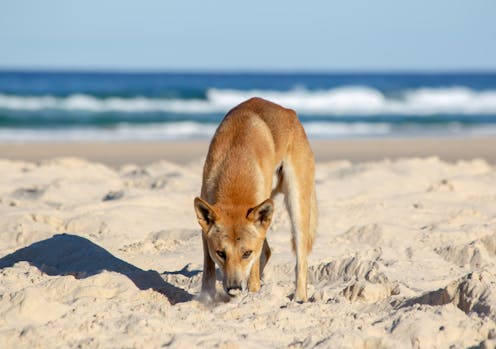Dingo attacks are rare – but here's what you need to know about dingo safety
- Written by Bill Bateman, Associate professor, Curtin University

Australia has an ambivalent relationship with dingoes – to some they are almost magical representations of our arid landscapes, responsible for holding back a tide of foxes and feral cats, as found in some studies.
To others they are pests, dangerous marauders of our cattle and sheep. We even argue about what to call them. They also loom large in our national conscience as potential killers of children, as shown by a recent dingo attack on a child on K'gari (Fraser Island).
Why do dingoes attack?
Dingo attacks on humans are very rare, and in most cases where humans have been attacked, the dingoes have become habituated to humans and have perhaps lost some fear of them.
This is usually because they have come to associate people with food, though not necessarily as food. This kind of habituation is seen in many animals across the world, including large carnivores such as bears and coyotes in North America, and even spotted hyaenas in Ethiopia.
The recent attack on K’gari has another facet, though. The child was attacked while sitting in shallow water at the beach, and the event highlights that dingoes can be predators. There is no indication the dingo was trying to take food from the child; it’s possible it was tentatively seeing if the child was suitable as prey.
Children as prey
A 2017 study of dingo attacks on K’gari showed most of the dingoes involved were young ones, and children who were some distance from an adult were often the recipients of attacks.
In 2001, a nine-year-old boy was tragically killed by two dingoes on K’gari when he was standing some distance away from the rest of his family and tripped and fell over. A five-year-old boy who was badly bitten by dingoes on K’gari in 2022 was attacked when his elder brother walked away from him.
In all these cases, although there were other people nearby, the dingoes selected the smallest and most separated person. This suggests that a hunting response was triggered – a child is not much bigger than normal dingo prey (such as wallabies). The dingoes involved were perhaps young and exploratory.
In fact, you can often see such reactions in zoo animals – lions, tigers and other big cats often ignore adult humans looking at them, but become excited when they see a child; the smaller size seems to trigger a predatory response.
How can you stay safe from dingoes?
The bottom line is dingoes are wild animals and can sometimes act as predators towards us, especially the smallest humans.
Dingoes are found across Australia, though they are less common in pastoral areas where lethal control occurs. They tend to avoid people wherever possible. K'gari dingoes are protected for their high conservation value, because they show little evidence of inbreeding with domestic dogs. As a result, these island dingoes are much bolder. Visitors need to treat them with respect.
So how do we stay safe? We should always be on high alert around such animals, especially in places where dingoes are more common and bolder. As with any wildlife, we should leave dingoes alone as much as possible, and keep a respectful distance. We also should avoid leaving food around, which could attract attention in the first place.
But if you do encounter a dingo (or several), here’s what to do:
- stay alert and keep a safe distance
- avoid being alone or, if in a group, don’t spread too far out
- stay close to any children in your group
- don’t run or turn your back on the dingo, as this may trigger an attack.
People often feel they should not act aggressively if approached by a carnivore, but studies on wolves and pumas suggest that shouting and throwing things is actually more likely to prevent an attack – don’t be afraid to resort to this if you feel threatened.
Anything that makes you, or the people with you, seem less like prey – less enticing – is good. Stay safe, but most importantly, respect these animals for the wild creatures they are.
Authors: Bill Bateman, Associate professor, Curtin University





